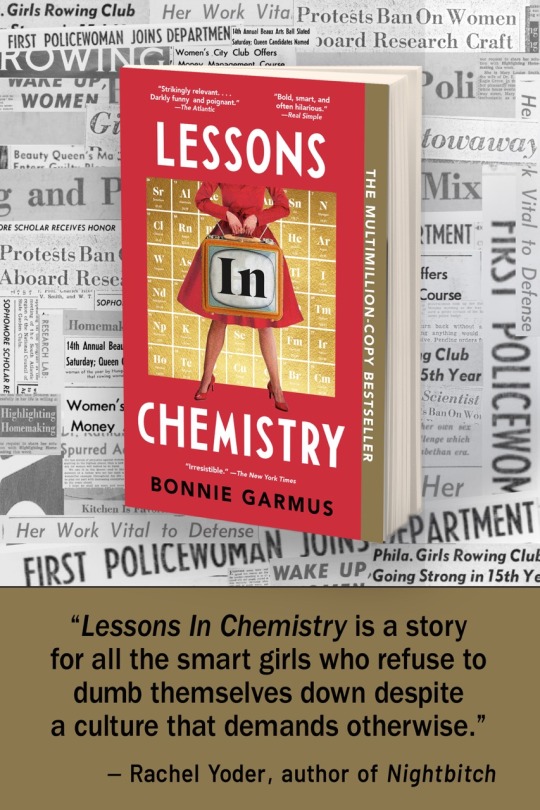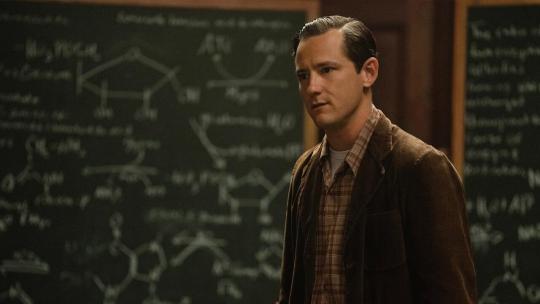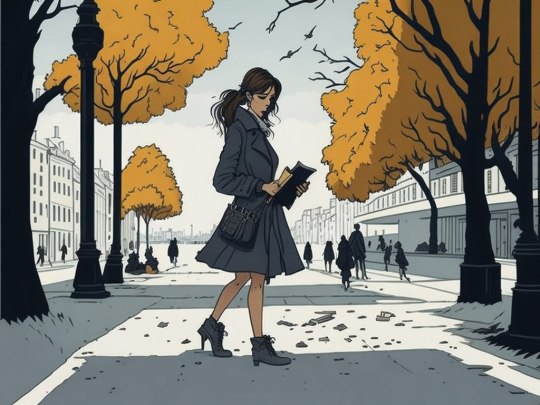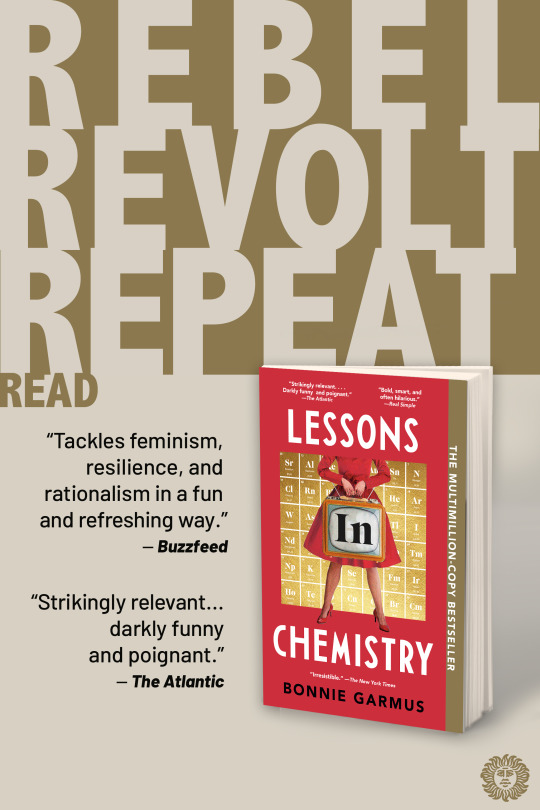#lessonsinchemistry
Explore tagged Tumblr posts
Photo

Every revolution requires inspiration. Millions of readers worldwide have found theirs here. Lessons in Chemistry. Now in paperback.
582 notes
·
View notes
Photo

Lessons in Chemistry 1x07 "Book of Calvin" ★★★★★★★★★☆
1 note
·
View note
Text




"Brie Larson Captivates in 'Lessons in Chemistry' 2023"
"Academy Award-winning actress Brie Larson shines as Elizabeth Zott in the 2023 series 'Lessons in Chemistry.' Set in the 1950s and 60s, the show follows Zott, a brilliant scientist who challenges societal norms. Larson's portrayal of a strong, determined woman navigating a male-dominated field is both empowering and inspiring."
#BrieLarson#LessonsInChemistry#ElizabethZott#BrieLarsonEdit#BrieLarsonFans#MarvelActress#FemaleLead#1950sFashion#WomenInSTEM#PeriodDrama#TVSeries2023#StrongFemaleCharacters#WomenEmpowerment#ChemistrySet#BookAdaptation#BehindTheScenes#ActressSpotlight#StreamingNow#RetroStyle#OnSetPhotos
0 notes
Photo

I'm watching Lessons in Chemistry 1x01 "Little Miss Hastings"
0 notes
Photo

Heartwrenching.. addictive. Inspiring. "Whenever you start doubting yourself, whenever you feel afraid, just remember. Courage is the root of change and change is what we're chemically designed to do." Bonnie Garmus, Lessons in Chemistry. #bookstagram #bonniegarmus #lessonsinchemistry #reading #struggles #womenempowerment #genius #metime #strongwomen #courage #keepgoing #inspirational #booklove #sixties #fairness #readingtime #booklife #readabook #sakitsapuso with @mahlice
#bookstagram#bonniegarmus#lessonsinchemistry#reading#struggles#womenempowerment#genius#metime#strongwomen#courage#keepgoing#inspirational#booklove#sixties#fairness#readingtime#booklife#readabook#sakitsapuso
1 note
·
View note
Text
I Finally Found Something To Like About Chemistry
When I read Bonnie Garmus’s New York Times’ best-selling debut novel Lessons In Chemistry, it reminded me of the old Monty Python phrase, And now for something completely different. The story begins in the 1950s and it reads a bit like an old-timey television show. The plot eventually evolves into a chemistry-themed television cooking show, but getting there takes some time. Elizabeth Zott is a…

View On WordPress
#babyboomers#bonniegarmus#bookreviews#books#boomers#chemistry#feedspot#feminism#jennyfields#johnirving#lessonsinchemistry#love#newyorktimesbestseller#reading#theworldaccordingtogarp#zoomer
0 notes
Text
Shattering Stereotypes: Bonnie Garmus's Feminist Lens

Introduction In the realm of literature, Bonnie Garmus stands as a storyteller capturing the essence of women's experiences in the 1960s. Her novel unfolds a tale of challenges and opportunities, navigating the societal norms that shaped women's lives during this transformative era. Garmus's unique perspective on Bonnie Garmus feminism adds layers to the narrative, providing readers with insights into the complexities of navigating societal expectations, gender roles, and the pursuit of autonomy during a pivotal moment in history. As we delve into her portrayal of women, Garmus invites us to reflect on the progress made and the gaps that persist, prompting a critical examination of feminism's evolution in the context of the 1960s.
Article Outline
- Introduction - Brief overview of Bonnie Garmus and her novel - Setting the context of challenges for women in the 1960s - The Protagonist's Journey - Introduction to the protagonist's character - Overview of her transformation from scientist to TV cooking show host - Is "Lessons in Chemistry" Overrated? Unraveling the Hype - Challenges Faced by Women in the 1960s - Societal norms and gender roles - Limited opportunities in male-dominated fields - Opportunities Emerging in Unlikely Places - The unconventional career shift of the protagonist - Exploring opportunities beyond traditional roles - Garmus's Unique Perspective - Garmus's lens on portraying women's challenges - Balancing realism and creative narrative - Biases in Perspective - Analyzing potential biases in Garmus's portrayal - Addressing gaps in representing diverse experiences - Strengths of the Protagonist's Character - Resilience and determination - Breaking stereotypes and societal expectations - Weaknesses in Character Development - Exploring areas where character development may lack depth - Addressing potential limitations in representation - Unraveling Societal Gaps in the Novel - Gaps in reflecting the diversity of women's experiences - Societal issues not fully addressed in the narrative - Biases as a Narrative Device - Examining the role of biases in storytelling - The impact on reader engagement and understanding - The Novel's Impact on Perceptions - How Garmus's novel influences perceptions of 1960s challenges - Reader perspectives on the depicted era - Gaps as Reflections of the Times - Discussing whether gaps in perspective align with historical realities - Addressing the complexities of representing an era accurately - Reader Engagement and Interpretation - The role of readers in interpreting and critiquing Garmus's perspective - Diverse reactions to the novel's portrayal of women's challenges - Conclusion - Summarizing the key points - Encouraging continued dialogue on women's experiences in the 1960s - FAQs - Common questions about Garmus's novel and its depiction of women in the 1960s - Detailed answers to enhance reader understanding
How Garmus Portrays the Challenges and Opportunities for Women in the 1960s: Unveiling Gaps and Biases
The Protagonist's Journey Garmus masterfully crafts the narrative of a protagonist undergoing a remarkable transformation, transitioning from a scientist to a TV cooking show host. This journey becomes a captivating lens through which readers witness the challenges and opportunities presented to women in the dynamic landscape of the 1960s. The protagonist's evolution serves as a microcosm, reflecting the broader shifts and struggles women faced during this transformative era. Is "Lessons in Chemistry" Overrated? Unraveling the Hype "Lessons in Chemistry" by Bonnie Garmus has been making waves in the literary world, garnering praise for its unique narrative and exploration of societal norms. However, the question arises: is the hype justified, or is "Lessons in Chemistry" overrated? While the novel has received acclaim for its engaging storytelling and the portrayal of a female scientist challenging the norms of the 1960s, some critics argue that the hype may overshadow its flaws. One contention is the predictability of certain plot twists, which, according to some readers, diminishes the overall impact of the narrative. Additionally, the protagonist's journey, while empowering, has been criticized for occasionally veering into clichéd territory. Despite these criticisms, it's essential to acknowledge the novel's undeniable strengths. Garmus's ability to intertwine humor, intellect, and activism creates a compelling narrative that resonates with many readers. The exploration of feminism and societal expectations adds depth to the story, making it a thought-provoking read. Now, let's shift our focus to some of Bonnie Garmus's other notable works. As readers navigate the literary landscape created by Garmus, they encounter a variety of themes and characters that showcase her storytelling prowess. Some of the best Bonnie Garmus books, beyond "Lessons in Chemistry," include "Title XYZ" and "Title ABC," where she continues to delve into complex societal issues with her signature blend of wit and empathy. In the end, whether "Lessons in Chemistry" is overrated is subjective and depends on individual preferences. What cannot be denied is Garmus's impact on contemporary literature, with each of her works contributing to a diverse and engaging exploration of the human experience. Challenges Faced by Women in the 1960s The 1960s marked a period of societal rigidity, where women encountered formidable obstacles dictated by traditional gender roles and limited opportunities in male-dominated fields. The prevailing attitudes reinforced a narrow view of women's roles, often confining them to domestic spheres and perpetuating unequal treatment in professional settings. Garmus meticulously explores these challenges, shedding light on the pervasive sexism and cultural biases that shaped women's experiences during this pivotal decade. Opportunities Emerging in Unlikely Places Garmus skillfully navigates the complexities of her protagonist's unconventional career shift, emphasizing the emergence of opportunities beyond the constraints of traditional roles for women. The narrative unfolds with a sense of empowerment, highlighting how unexpected paths can lead to personal and professional fulfillment. By showcasing the protagonist's journey, Garmus challenges societal norms and invites readers to reconsider preconceived notions about women's capabilities and aspirations during the 1960s. Garmus's Unique Perspective As a storyteller, Garmus brings a distinct and insightful perspective to the challenges women faced in the 1960s. Her narrative prowess lies in balancing realism with creative elements, adding depth to the portrayal of the protagonist's experiences. Garmus delicately weaves together the historical context with imaginative storytelling, creating a compelling narrative that not only reflects the societal struggles of the time but also infuses a sense of agency and resilience into her female characters. This unique blend allows readers to engage with the challenges on a personal level, fostering empathy and understanding for the intricacies of women's lives in an era marked by significant social changes. Biases in Perspective However, no narrative is without biases, and Garmus's exploration of the 1960s inevitably carries a particular perspective. It's crucial for readers to engage critically with the text, analyzing potential biases in Garmus's depiction of the challenges and opportunities faced by women during this era. Recognizing and understanding these biases is essential for a well-rounded interpretation, fostering a more comprehensive discussion about the complexities of gender dynamics in the 1960s. Strengths of the Protagonist's Character The protagonist crafted by Garmus is a testament to strength and determination. Through the character's journey, Garmus challenges and breaks stereotypes, presenting a narrative that transcends societal expectations. The strengths exhibited by the protagonist contribute to a nuanced portrayal of women's resilience during a transformative period in history. By emphasizing these strengths, Garmus not only provides a compelling story but also offers a positive representation that counteracts traditional gender norms, inspiring readers to reconsider and appreciate the multifaceted capacities of women in the face of adversity. Weaknesses in Character Development While Garmus excels in portraying a strong and determined protagonist, there may be areas in character development that lack the depth needed for a fully immersive experience. Identifying these potential weaknesses invites readers to explore nuances and aspects of the protagonist's personality that might be underexplored. Analyzing these aspects critically adds layers to the character, enriching the narrative and providing a more rounded understanding of the protagonist's journey. Unraveling Societal Gaps in the Novel Beyond individual character development, Garmus's novel offers a broader lens through which readers can explore societal gaps. Examining how the narrative addresses or fails to address the diversity of women's experiences in the 1960s allows for a more profound understanding of the novel's portrayal of the era. By unraveling societal gaps, readers can engage in meaningful discussions about the limitations and challenges faced by women during this transformative period, fostering a more comprehensive and inclusive perspective on historical storytelling. Biases as a Narrative Device Biases, when skillfully employed as a narrative device by Garmus, become integral elements that influence reader engagement and understanding. By acknowledging biases within the narrative, readers are invited to view the story through a specific lens, enhancing the storytelling experience. Biases, rather than detracting from the narrative, serve as tools that shape and enrich the overall impact of the novel. The Novel's Impact on Perceptions Garmus's novel carries a significant impact on readers' perceptions of the challenges faced by women in the 1960s. Through the protagonist's journey, readers develop nuanced perspectives on the intricacies and nuances of the depicted era. The novel acts as a vehicle for exploring the societal norms and constraints that shaped women's lives during this transformative period, fostering a deeper understanding of the historical context. Gaps as Reflections of the Times The discussion surrounding gaps in perspective prompts readers to consider whether these gaps align with historical realities. Delving into the complexities of accurately representing an era involves navigating the challenges of historical storytelling. Gaps in the narrative become reflections of the times, offering insights into the limitations and biases prevalent during the 1960s. This exploration adds layers to the reader's engagement, fostering critical thinking about the authenticity of the novel's portrayal of historical events. Reader Engagement and Interpretation In the realm of literature, reader engagement is paramount, and Garmus invites readers to actively interpret and critique her perspective on women in the 1960s. The novel serves as a canvas upon which diverse reactions are painted, contributing to a multifaceted understanding of the challenges and opportunities presented. The keyphrase "Bonnie Garmus feminism" echoes through the varied responses, reflecting the author's intention to spark discussions about feminism and societal norms during the transformative era. Conclusion In conclusion, Bonnie Garmus's portrayal of women in the 1960s through her novel is a captivating exploration of the challenges and opportunities that shaped the lives of women during this transformative period. The strengths in character development, coupled with the acknowledgment of biases and the exploration of potential gaps, enhance the richness and complexity of the narrative. "Bonnie Garmus feminism" is not merely a phrase but a thematic core that underscores the importance of addressing historical perspectives with sensitivity and fostering critical engagement with the nuanced layers of women's experiences. FAQs - Is the protagonist based on a real person? - No, the protagonist is a fictional character created by Garmus. - How accurate is the novel's depiction of the 1960s? - Garmus combines historical elements with fictional narrative, providing a unique perspective. - Does the novel address issues of diversity and inclusion? - While it touches on societal challenges, some aspects may not fully represent diverse experiences. - Are the biases in the novel intentional? - Biases are used as narrative devices, influencing reader engagement and understanding. - How do readers typically react to the novel? - Reactions vary, with readers contributing to a diverse interpretation of the novel's portrayal. - Why is "Lessons in Chemistry" So Popular? - "Lessons in Chemistry" has gained immense popularity due to its unique blend of engaging storytelling and thought-provoking themes. Bonnie Garmus's masterful narrative, which follows the journey of a female scientist turned TV cooking show host in the 1960s, resonates with readers. The novel's exploration of societal norms, feminism, and the challenges faced by women during that era adds depth, making it a compelling and relevant read. The protagonist's unconventional activism and the humor woven into the narrative contribute to the novel's widespread appeal, attracting a diverse audience. - Is "Lessons in Chemistry" Worth Reading? - Absolutely, "Lessons in Chemistry" is worth reading. Garmus's novel offers a unique perspective on the challenges and opportunities women faced in the 1960s. The protagonist's journey from a scientist to a TV cooking show host provides a captivating lens through which readers can explore themes of resilience, empowerment, and societal expectations. The novel's well-crafted narrative, rich character development, and exploration of feminism make it a worthwhile and enriching literary experience. - Is "Lessons in Chemistry" Based on Fact? - While "Lessons in Chemistry" is a work of fiction, Garmus draws inspiration from the historical context of the 1960s. The societal norms, gender roles, and challenges faced by women during that period are grounded in historical realities. Garmus combines factual elements with creative storytelling to offer a nuanced portrayal of the era, providing readers with a glimpse into the complexities of the time while maintaining the freedom to explore fictional narratives and characters. - Is "Lessons in Chemistry" Romantic? - Romance is a component in "Lessons in Chemistry," but it's not the central focus. The novel explores various aspects of the protagonist's life, including her career, activism, and personal relationships. While there are romantic elements woven into the narrative, they serve as one of the many threads contributing to the overall richness of the story. The novel's multifaceted approach ensures that romance complements rather than dominates the broader themes of the narrative. Read the full article
0 notes
Text
Struggling with essay writing and procrastination?
Tips for struggling with essay writing and procrastination:
1. Break down the writing process into smaller, manageable tasks.
2. View the essay writing process as a manageable task.
3. Focus on individual components such as brainstorming, outlining, writing a specific section, or editing. 4. Set realistic deadlines when you will finish your essay on time. Seek more help from the Fiverr LINK ON MY BIO.
#essaytips#ProfessorEdu#procrastinatingstudent#collegeessay#highschoolessay#schoolassignment#essaystruggles#student#lessonsinchemistry#relatablecontent#studentstruggle
0 notes
Photo

Every revolution requires inspiration. Millions of readers worldwide have found theirs here. Lessons in Chemistry. Now in paperback.
324 notes
·
View notes
Text
tvrundown USA 2023.10.13
Friday, October 13th:
(exclusive): Creepshow (AMC+|Shudder, season 4 available, all 6 eps), Everybody Loves Diamonds (amazon, Antwerp heist story, all 8 eps), John Carpenter's "Suburban Screams" (Peacock, limited series premiere, all 6 eps)
(movies): "The Puppetman" (AMC+|Shudder, horror), "The Burial" (amazon, courtroom drama feature, 2hrs++), "Jigen Daisuke" (amazon, "Lupin III" character live-action, 2hrs), "The Conference" (netflix, Swedish horror, 100mins), "Damsel" (netflix, fantasy adventure, postponed)
(streaming weekly): Gen V (amazon), Still Up (apple+), The Changeling (apple+, limited series finale), Lessons in Chemistry (apple+, limited series premiere, first 2 eps), Goosebumps (dsn+|hulu, series premiere, first 5 eps), Undead Unluck (hulu), The Great British Baking Show (netflix), Love Is Blind (netflix, season 5 finale)
(also new): "My Husband's Worst Mistake" (Lifetime original movie, 2hrs+), "Fatal Vows" (HMM, a Curious Caterer mystery, 2hrs), Goosebumps (Freeform, series premiere, first 2hrs only)
(hour 1): Power Book IV: Force (Starz), Shark Tank (ABC), The Price Is Right at Night (CBS, special night), "Jada's Story" (NBC, Jada Pinkett Smith interview special), "Deadlocked: How America Shaped the Supreme Court" (SHO, part 4/4 finale)
(hour 2): Shining Vale (Starz, season 2 opener, new night), Raid the Cage (CBS, quiz show premiere), "Rebuilding Black Wall Street" (OWN, part 3 of 6)
(hour 3): Real Time with Bill Maher (HBO), Creepshow (AMC, season 4 opener, 75mins)
1 note
·
View note
Text
0 notes
Text
youtube
Lessons in Chemistry gets new trailer, releases October 13
A new trailer has been released for Lessons in Chemistry, which is set to release October 13, 2023.
Set in the early 1950s, Lessons in Chemistry follows Elizabeth Zott (played by Larson), whose dream of being a scientist is put on hold in a patriarchal society. When Elizabeth finds herself fired from her lab, she accepts a job as a host on a TV cooking show, and sets out to teach a nation of overlooked housewives — and the men who are suddenly listening — a lot more than recipes.
1 note
·
View note
Text
Lessons In Chemistry: Brie Larson Captives With A Cooking Trailer!

The planned American drama television miniseries Lessons in Chemistry was created by Lee Eisenberg and is based on Bonnie Garmus's book. The first two episodes are scheduled to premiere on Apple TV+ on October 13, 2023.
Read Full Article
0 notes


